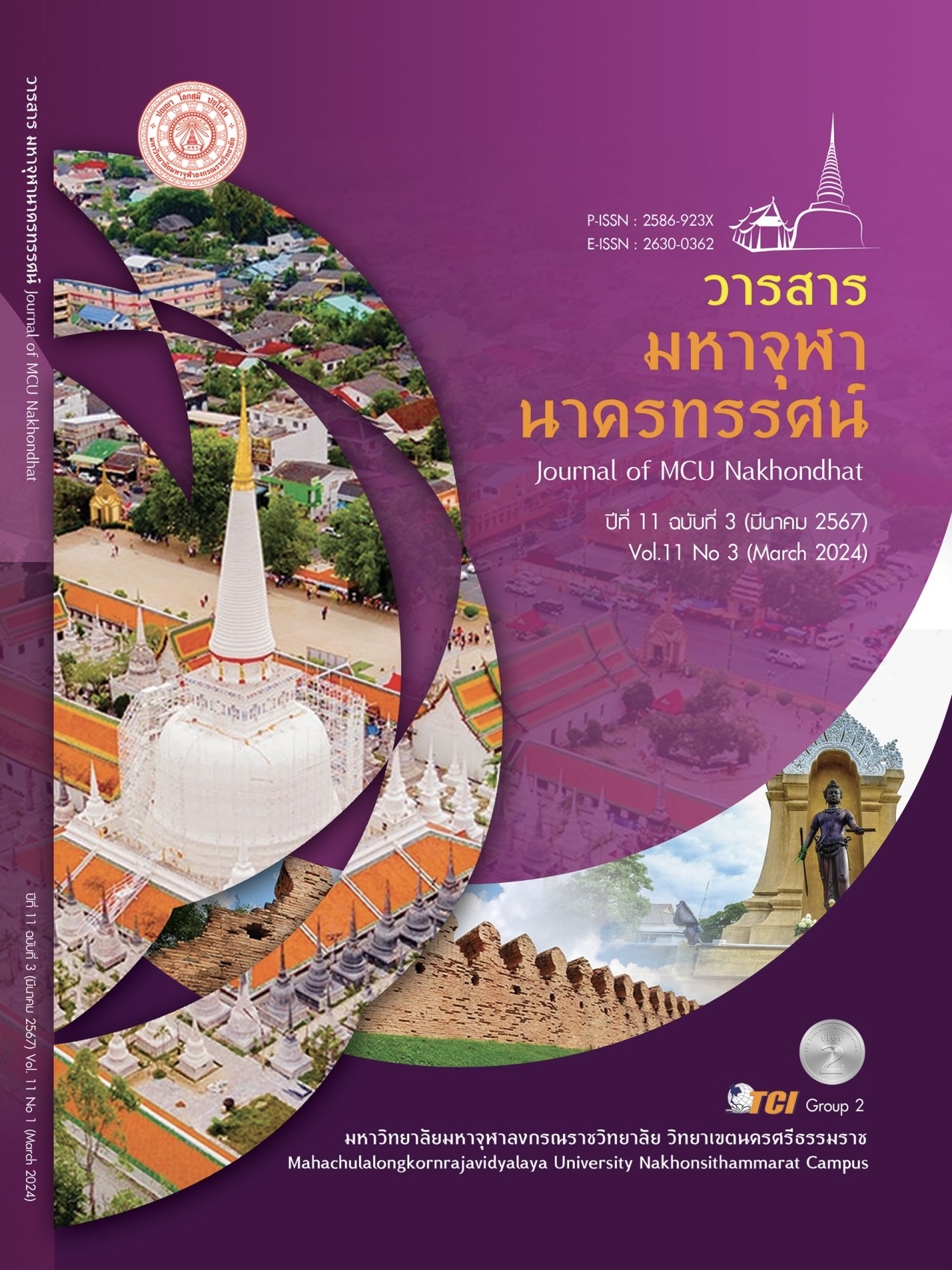PROFESSIONAL NURSES AT SUBDISTRICT HEALTH PROMOTING HOSPITALS : MOTIVATION REMAINS ON THE JOB
Main Article Content
Abstract
The purpose of this article is present information about the increasing work role of professional nurses at Subdistrict Health Promoting Hospitals, which results in fatigue and inability to endure regular work. This is caused by the health system reform policy and the Thailand 4.0 policy that focuses on the development of the primary care system. By specifying the establishment Family doctor clinic team and primary care medical system management There are family medicine doctors working to provide services to the public. Continuously integrated and holistic Using the motivation process That consists of using the theory covering the theory of hierarchy of needs. intrinsic motivation theory Extrinsic Motivation Theory that satisfies a person's inner needs or desires encourage behavior Specific needs or internal needs that motivate and direct the way a person expresses their behavior, together with the theory of two factors that consist of motivating factors. Maintenance factors and process theory That involves the cognitive process of deciding and choosing behavior. From the factors that stimulate motivation Covers goal setting theory Expectancy Theory and fairness theory Together with the assessment of the context of the area that affects the difficulties in the work of professional nurses at the Subdistrict Health Promoting Hospital, it will be something that those involved in policy making should create and push for morale and motivation to maintain. Delay, hold back, allow the professional nurses of the Subdistrict Health Promoting Hospital to remain in their jobs willingly. and are attached to the organization, work, co - workers, and area; have unwavering determination to remain in the same organization Work with happiness Affects the efficiency and effectiveness of work. and important results It is the quality of life of service recipients and service providers that is in balance with each other.
Article Details

This work is licensed under a Creative Commons Attribution-NonCommercial-NoDerivatives 4.0 International License.
References
กองแก้ว ย้วนบุญหลิม และคณะ. (2564). คุณภาพชีวิตการทำงานของบุคลากรทางการแพทย์ โรงพยาบาลวชศาสตร์เขตร้อน คณะเวชศาสตร์เขตร้อน มหาวิทยาลัยมหิดล. วารสารการพยาบาลและการดูแลสุขภาพ, 39(1), 59-67.
จิรณัฐ ชัยชนะ. (2561). การศึกษาบทบาทพยาบาลวิชาชีพในโรงพยาบาลส่งเสริมสุขภาพตำบล. ใน วิทยานิพนธ์พยาบาลศาสตร์มหาบัณฑิต สาขาพยาบาลศาสตร์. จุฬาลงกรณ์มหาวิทยาลัย.
โชติกา ระโส. (2555). แรงจูงใจในการปฏิบัติงานของบุคลากรมหาวิทยาลัยราชภัฏนครสวรรค์. ใน วิทยานิพนธ์มหาบัณฑิต สาขาวิชาการอุดมศึกษา. มหาวิทยาลัยศรีนครินทรวิโรฒ.
ธนพร ปทุมรังสรรค์. (2557). ปัจจัยที่ส่งผลต่อการคงอยู่ในองค์การของพนักงานกลุ่ม Generation Y: กรณีศึกษากลุ่มธุรกิจออนไลน์แห่งหนึ่ง. ใน การค้นคว้าอิสระหลักสูตรบริหารธุรกิจมหาบัณฑิต คณะพาณิชยศาสตร์และการบัญชี. มหาวิทยาลัยธรรมศาสตร์.
ธนัญพร สุวรรณคาม. (2559). ปัจจัยด้านแรงจูงใจในการทำงาน ความพึงพอใจในงานที่ส่งผลต่อความผูกพันต่อองค์การของพนักงานธนาคารพาณิชย์แห่งหนึ่ง. ใน วิทยานิพนธ์ศิลปศาสตรมหาบัณฑิต สาขาวิชาจิตวิทยาอุตสาหกรรมและองค์การ. มหาวิทยาลัยธรรมศาสตร์.
มารศรี ก้วนหิ้น. (2561). การพัฒนาสมรรถนะพยาบาลวิชาชีพ ที่ปฏิบัติงานในโรงพยาบาลส่งเสริมสุขภาพตำบลจังหวัดนครศรีธรรมราช. วารสารวิชาการแพทย์เขต 11, 32(2), 1067-1080.
วริญากร ธนอัครสวัสดิ์ และคณะ. (2558). ความสัมพันธ์ระหว่างคุณภาพชีวิตการทำงานกับการคงอยู่ในงาน ของพยาบาลวิชาชีพในโรงพยาบาลส่งเสริมสุขภาพตำบล เขตพื้นที่เครือข่ายบริการที่ 3. วารสารการพยาบาลและสุขภาพ, 9(2), 83-96.
วรุณศิริ พรพจน์ธนมาศ และคณะ. (2564). บทวิเคราะห์เชิงวิพากษ์ต่อการอธิบายแรงจูงใจในการทำงานผ่านทฤษฎีความเสมอภาคของ J. STACY ADAMS. วารสารวิชาการชลบุรี, 17(3), 180-190.
วิจิตร ศรีสุพรรณ และกฤษฎา แสวงดี. (2555). ข้อเสนอแนะเชิงนโยบายในการแก้ปัญหาการขาดแคลนพยาบาลวิชาชีพในประเทศไทย. วารสารสภาการพยาบาล, 27(1), 5-12.
สมจิต แดนสีแก้ว และคณะ. (2560). บริบทการทำงานของพยาบาลไทยในภาคตะวันออกเฉียงเหนือ. วารสารการพยาบาลและการดูแลสุขภาพ, 35(2), 216-224.
สมจิต หนุเจริญกุล. (2559). ชุดการเรียนรู้เพื่อการสร้างเสริมสุขภาพ:บทบาทพยาบาล สำนักสนับสนุนระบบพัฒนาและสร้างเสริมสุขภาพ. (พิมพ์ครั้งที่ 1). กรุงเทพมหานคร: บริษัท มาตาการพิมพ์.
สำนักสนับสนุนระบบสุขภาพปฐมภูมิ. (2565). คู่มือคุณภาพมาตรฐานบริการสุขภาพปฐมภูมิ พ.ศ. 2566. (พิมพ์ครั้งที่ 1). นนทบุรี: โรงพิมพ์องค์การสงเคราะห์ทหารผ่านศึก ในพระบรมราชูปถัมภ์.
อรพินทร์ ชูชม. (2555). แรงจูงใจ ในการทำงาน: ทฤษฎีและการประยุกต์. วารสารจิตวิทยามหาวิทยาลัยเกษมบัณฑิต, 2(2), 52-61.
อริศรา ถิ่นนุกูล และวงศ์ธีรา สุวรรณิน. (2561). แรงจูงใจในการทำงานที่ส่งผลต่อคุณภาพชีวิตในการทำงานของพนักงานบริษัท 2 เอสเมทัล จำกัด (มหาชน) และบริษัทในเครือ. การค้นคว้าอิสระคณะบริหารธุรกิจ: มหาวิทยาลัยรามคำแหง.
โอภาส จูเลิศตระกูล. (2564). ปัจจัยที่ส่งผลต่อแรงจูงใจในการปฏิบัติงานของพนักงานเจเนอเรชั่นวายในกรุงเทพมหานคร. ใน สารนิพนธ์ปริญญาการจัดการมหาบัณฑิต สาขาทุนมนุษย์และการจัดการองค์กรวิทยาลัยการจัดการ. มหาวิทยาลัยมหิดล.
Adams, J.S. (1965). Inequity in Social Exchange. Advancce in Experimental and Social Phycology, 2(2), 267-299.
Ellenbecker, C.H. (2004). A theoretical model of job reten¬tion for home health care nurses. Journal of Advanced Nursing, 47(3), 303-310.
Locke, A. (1976). The nature and causes of job satisfaction. Chicago: Rand McNally.
Taunton R.L, et al. (1989). Manager impact on Retention of hospital staff part 1. Jour¬nal of Nursing Administration, 19(3), 14-19.
Vroom, H .V. (1964). Work and Motivation. Now York: Wiley and Sons Inc.


